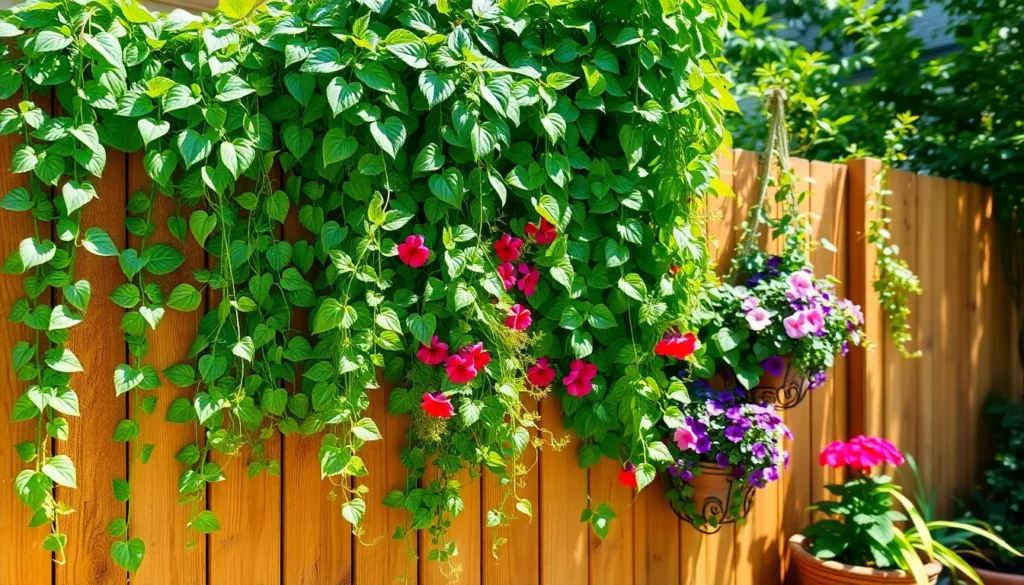We’ve all stared at that boring fence wondering how to transform it into something spectacular. Hanging plants on your fence isn’t just a trendy landscaping trick – it’s your secret weapon for creating a lush vertical garden that’ll make neighbors stop and stare.
Whether you’re dealing with a chain-link eyesore or a plain wooden barrier, we’re about to show you how to turn that forgotten space into a thriving green paradise. From selecting the perfect planters to choosing plants that’ll flourish in your exact conditions, hanging fence gardens offer endless possibilities for maximizing your outdoor space.
The best part? You don’t need a massive backyard or expert gardening skills to pull this off. With the right approach, your fence can become a stunning living wall that adds privacy, beauty, and even fresh herbs to your outdoor space. Let’s jump into everything you need to know about creating your own fence-hanging garden masterpiece.
Choose the Right Plants for Your Fence Display
Selecting the perfect plants transforms your fence display from ordinary to extraordinary. We’ll guide you through three essential factors that ensure your hanging garden thrives.
Select Trailing and Cascading Varieties
Trailing plants create stunning visual impact when they spill gracefully over fence edges. We recommend starting with pothos, which produces long vines that can extend 6-8 feet and adapts to various light conditions. English ivy offers dense coverage with its classic cascading habit, while sweet potato vine provides colorful foliage in purple, chartreuse, or bronze varieties.
Cascading flowers add vibrant color to your fence display throughout growing seasons. Petunias bloom continuously from spring through fall, creating colorful curtains that reach 12-18 inches in length. Bacopa produces delicate white or purple flowers on trailing stems, while lobelia offers intense blue blooms that cascade beautifully from elevated positions.
Succulent trailing varieties require minimal maintenance while delivering maximum visual appeal. String of pearls creates unique texture with its bead-like foliage, and burro’s tail develops thick, rope-like stems that can grow up to 3 feet long.
Consider Your Climate Zone and Sunlight Exposure
Sun-loving plants thrive in areas receiving 6-8 hours of direct sunlight daily. We suggest portulaca for hot, sunny fence locations since it tolerates drought conditions and produces brilliant flowers in yellow, pink, and orange. Nasturtiums climb naturally and produce edible flowers while requiring full sun exposure to bloom prolifically.
Shade-tolerant varieties perform best in areas receiving 2-4 hours of direct sunlight or filtered light throughout the day. Begonias offer continuous blooms in shaded fence areas, while coleus provides stunning foliage patterns in purple, green, and red combinations. Ferns create lush, tropical appearances in consistently shaded locations.
Climate zone considerations determine which plants survive winter temperatures in your area. Hardy perennials like creeping phlox return each year in zones 3-9, while tropical plants such as bougainvillea only survive year-round in zones 9-11.
Pick Plants Based on Fence Height and Space
Low fences under 4 feet work best with compact trailing plants that won’t overwhelm the structure. We recommend using small planters with herbs like trailing rosemary or thyme, which provide both visual appeal and culinary benefits. Million bells create dense flower coverage without excessive weight on shorter fence sections.
Medium height fences between 4-6 feet accommodate larger trailing varieties and multiple planter tiers. Hanging baskets positioned at different heights create layered displays, while longer trailing plants like morning glories can climb upward and cascade downward simultaneously.
Tall fences over 6 feet support dramatic cascading displays with plants that have extensive trailing habits. We suggest using sturdy planters for heavier plants like trailing geraniums or large ferns that create bold statements visible from greater distances. These installations require stronger mounting hardware to support increased weight loads.
Select Appropriate Hanging Containers and Hardware
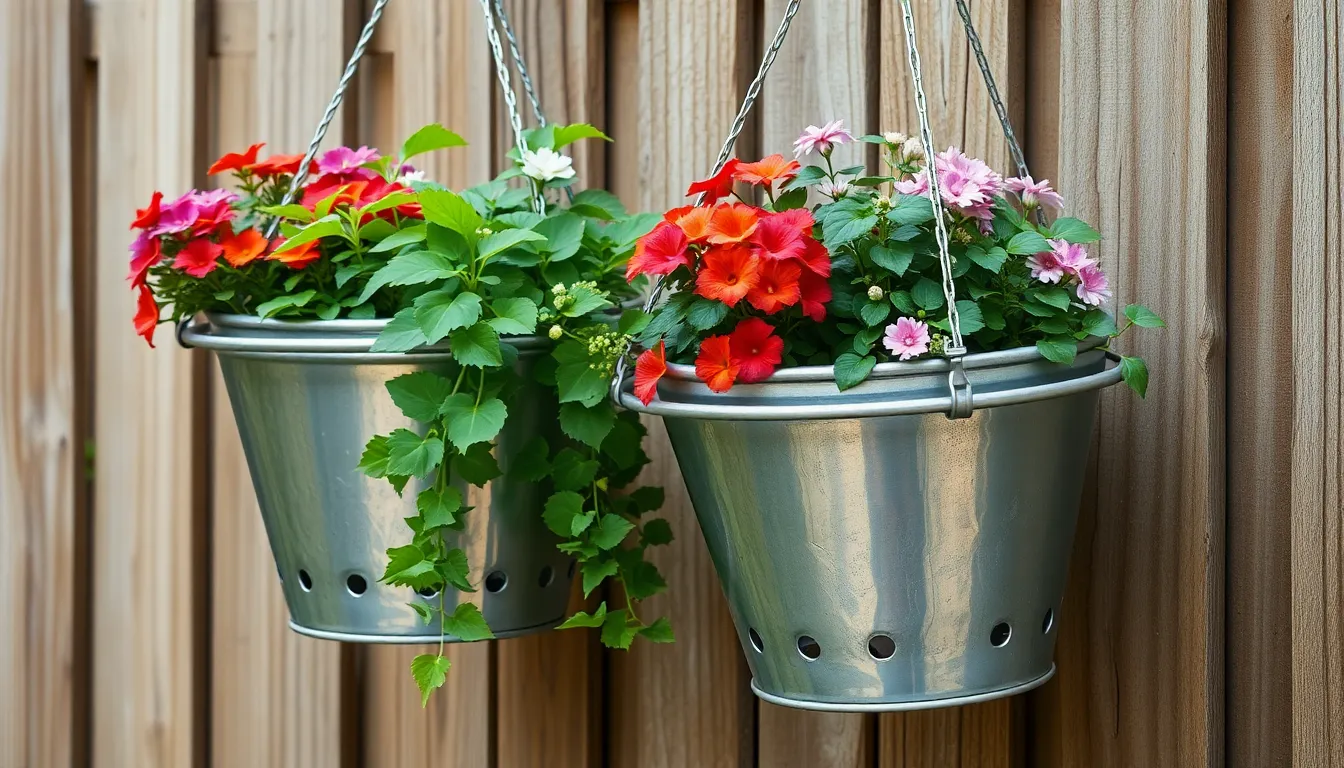
We’ll need the right containers and mounting hardware to create a secure fence display that keeps our plants healthy and thriving.
Choose Weather-Resistant Planters and Baskets
Metal hanging baskets with coco liners offer the perfect combination of durability and drainage for fence displays. These containers withstand sun and rain exposure while providing excellent air circulation for plant roots. We recommend choosing metal baskets for striking contrast with greenery or selecting woven baskets for a more natural aesthetic.
Material selection should complement your fence type to enhance both durability and visual appeal. Metal planters work beautifully with wooden fences while synthetic baskets pair well with PVC or composite materials. Weather resistant materials like treated metal or high quality synthetic materials ensure our containers maintain their appearance through seasonal changes.
Container sizing matters for both plant health and fence stability. Larger containers hold more soil moisture but require stronger mounting systems. We suggest matching container size to plant mature dimensions while considering the fence’s structural capacity.
Install Heavy-Duty Hooks and Mounting Systems
Secure mounting starts with drilling hooks or screws directly into fence posts or sturdy panels using fasteners long and strong enough to support planter weight plus moist soil. Heavy duty hooks, metal rings, or specialized outdoor clamps provide reliable attachment points for fence panels.
Reinforcement techniques work especially well for metal fences where we attach vertical timber beams first then mount our hooks or baskets to these support beams. This method increases overall stability and distributes weight more evenly across the fence structure.
Alternative mounting options include shepherd’s hook style metal posts when fence mounting presents challenges. These freestanding supports position near the fence line while providing flexible placement options for our hanging displays.
Consider Drainage Answers for Container Plants
Proper drainage holes prevent waterlogged soil and root rot in fence mounted containers. We ensure adequate drainage by using containers with built in holes or adding liners that allow excess water to escape naturally.
Watering frequency requires careful monitoring since hanging plants on fences dry out faster due to increased sun and wind exposure. We adjust our watering schedule based on weather conditions and plant needs rather than following rigid timetables.
Drainage monitoring helps us identify when containers need attention. Signs of poor drainage include yellowing leaves, musty soil odors, or water pooling in container bottoms. We address these issues promptly to maintain healthy root systems throughout the growing season.
Determine the Best Fence Locations for Plant Health
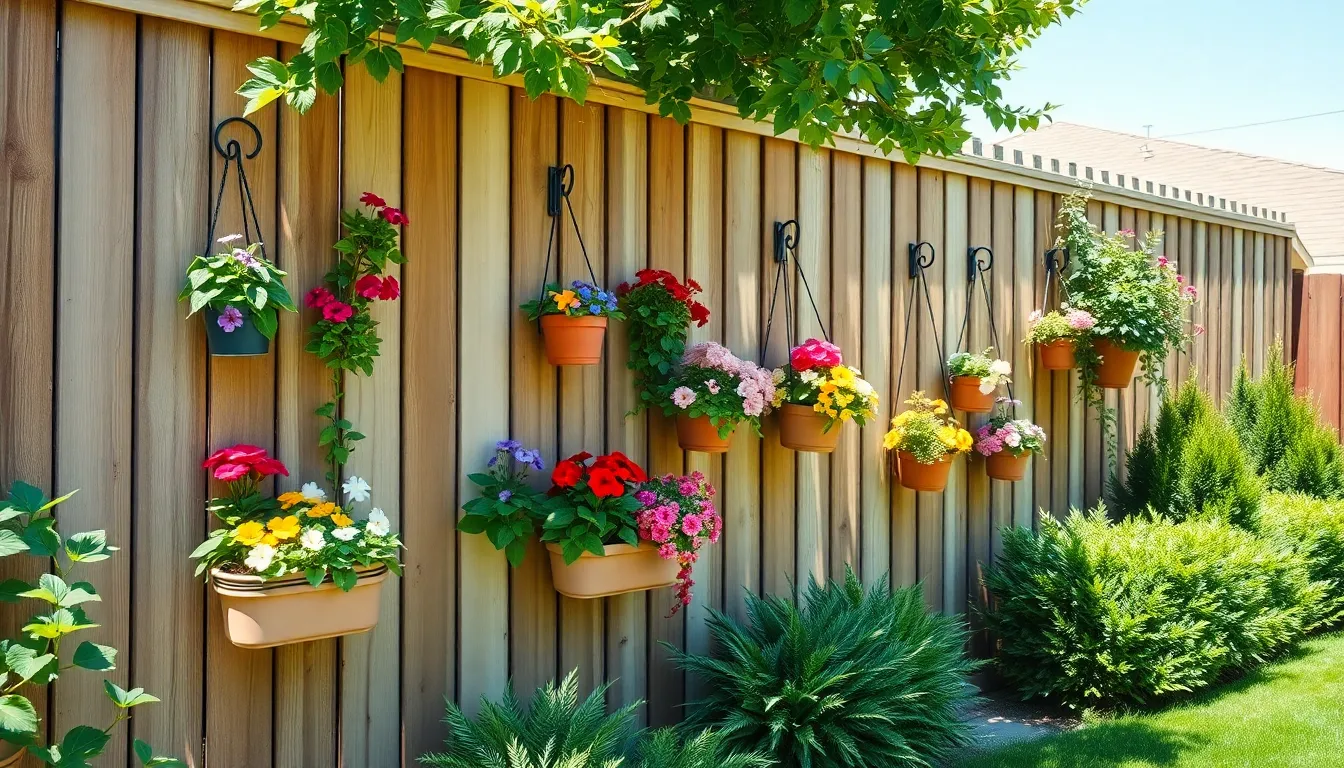
Now that we’ve selected our containers and hardware, we need to identify the optimal spots along our fence where plants will thrive. Strategic placement ensures our hanging garden receives proper environmental conditions while remaining accessible for maintenance.
Assess Sunlight Patterns Throughout the Day
Observing our fence area at different times reveals crucial information about light exposure patterns. We should track how many hours of direct sunlight each section receives, as this directly impacts plant selection and placement success.
Matching plants with their exact sunlight requirements prevents stress and promotes healthy growth. Sun-loving plants like petunias and geraniums need 6+ hours of direct light daily, while shade-tolerant varieties such as begonias and impatiens thrive with less exposure.
Positioning heavier planters lower on the fence takes advantage of typically shadier lower sections while placing lighter containers higher where they can access more sunlight. This strategic arrangement also creates visual balance and makes maintenance easier.
Evaluate Wind Exposure and Protection Needs
Avoiding exposed fence locations protects our plants from strong winds that can damage foliage and rapidly dry out soil. We should identify areas where natural structures or neighboring fences provide windbreaks.
Installing artificial hedges offers excellent protection when natural barriers aren’t available. These panels can be stapled or screwed directly onto fence structures, creating effective wind shields for our hanging plants.
Selecting fence sections with moderate air circulation promotes healthy plant growth while avoiding areas with excessive wind exposure. Gentle breezes help prevent fungal issues, but strong gusts stress plants and increase watering needs.
Plan for Easy Access and Maintenance
Hanging planters at convenient heights makes routine care tasks manageable and enjoyable. We should position containers within comfortable reach for watering, pruning, and seasonal plant changes.
Using secure mounting methods like French cleats or heavy-duty metal brackets ensures stability while allowing easy removal when needed. These systems provide reliable support and simplify maintenance activities.
Creating modular arrangements with PVC pipes or gutters maximizes vertical space while keeping plants accessible. Tiered designs allow us to layer different plant varieties and create stunning visual displays that are easy to maintain throughout the growing season.
Install Secure Mounting Systems for Safety
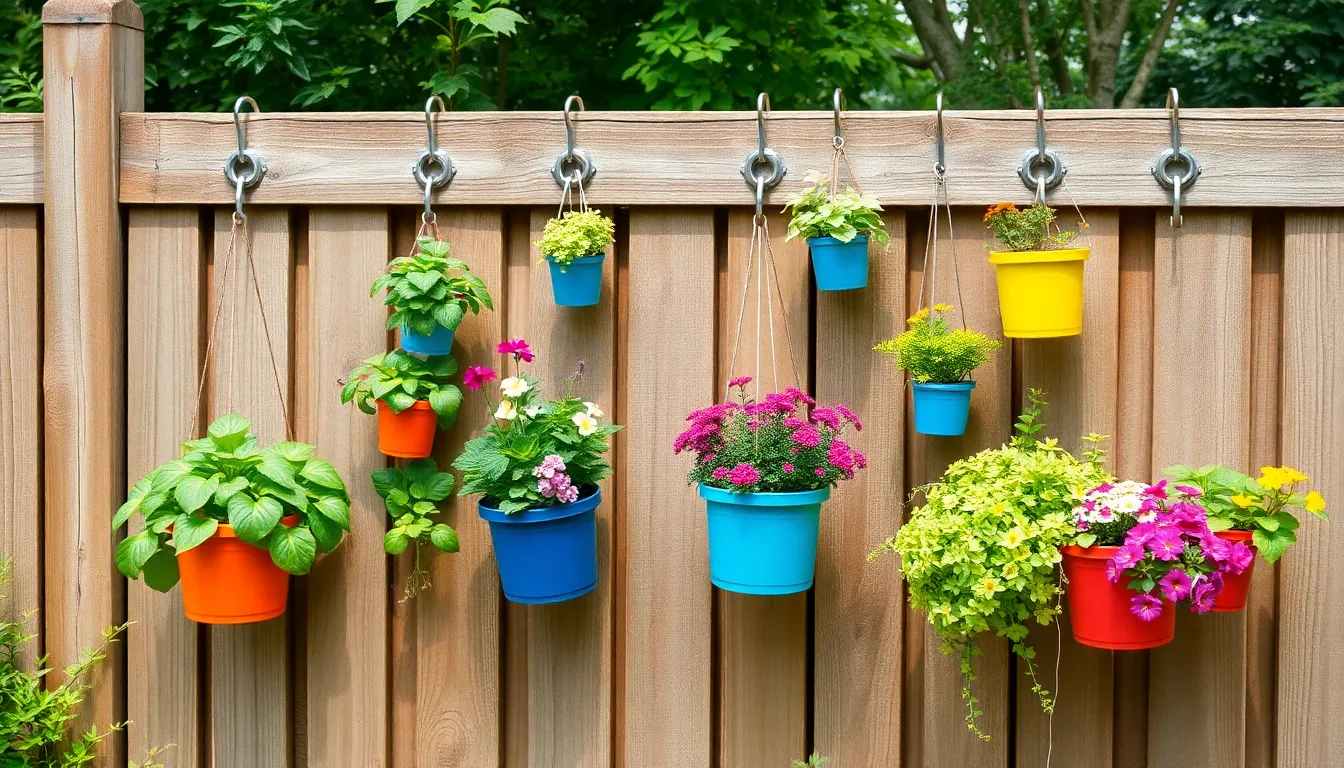
We’ll establish a foundation that protects both your plants and property by implementing secure mounting systems designed specifically for hanging gardens. Safety becomes our top priority when we’re supporting the combined weight of containers, soil, plants, and water against vertical surfaces.
Use Proper Screws and Anchors for Fence Material
Metal rings and clamps provide the most reliable attachment points for hanging plant containers on fences. We recommend using these specialized hardware pieces because they distribute weight evenly and resist weather-related loosening over time.
Wooden fences allow us to drive screws or staples directly into the material for secure mounting. Drill pilot holes first to prevent splitting, then attach brackets or hooks using galvanized screws that won’t rust or deteriorate.
Metal fences require a different approach since we can’t screw directly into the surface. Adding vertical timber beams creates solid mounting surfaces where we can attach our hanging hardware securely. These wooden supports should be pressure-treated and firmly bolted to the metal fence structure.
Ceiling hooks designed for hanging baskets work exceptionally well for fence installations. Choose hooks rated for outdoor use and verify they can support at least twice the expected weight of your planted containers.
Space Hanging Points for Even Weight Distribution
Uniform spacing prevents any single mounting point from bearing excessive weight that could damage the fence or cause plant containers to fall. We suggest measuring and marking hanging positions before installation to ensure consistent intervals along the fence line.
Long rows of fence planters benefit from brackets or clamps positioned every 24 to 36 inches depending on container size and plant weight. This spacing distributes the load across multiple fence sections rather than concentrating stress in one area.
Balance becomes crucial when we’re hanging multiple containers at different heights. Alternate heavy and light planters to prevent the fence from developing weak spots or sagging under uneven loads.
Corner areas and fence ends need special attention since these sections often have less structural support. We place our heaviest containers closer to fence posts where the structure provides maximum stability.
Test Weight Capacity Before Adding Plants
Weight testing prevents costly damage and potential safety hazards by confirming our mounting systems can handle the full load. We recommend loading each mounting point with sandbags or water containers that match the expected weight of planted containers.
Consider that wet soil weighs significantly more than dry soil, and plants add weight as they grow and mature. Factor in seasonal variations like rain accumulation or snow loads when calculating total weight capacity.
Test each mounting point individually by gradually adding weight until you reach 150% of the expected plant container weight. Any movement, creaking, or visible stress indicates the need for additional reinforcement or different mounting hardware.
Document weight limits for each hanging position so you can select appropriately sized containers and plants. This prevents accidentally overloading mounting points during future planting or container changes.
Create Visual Appeal with Strategic Placement
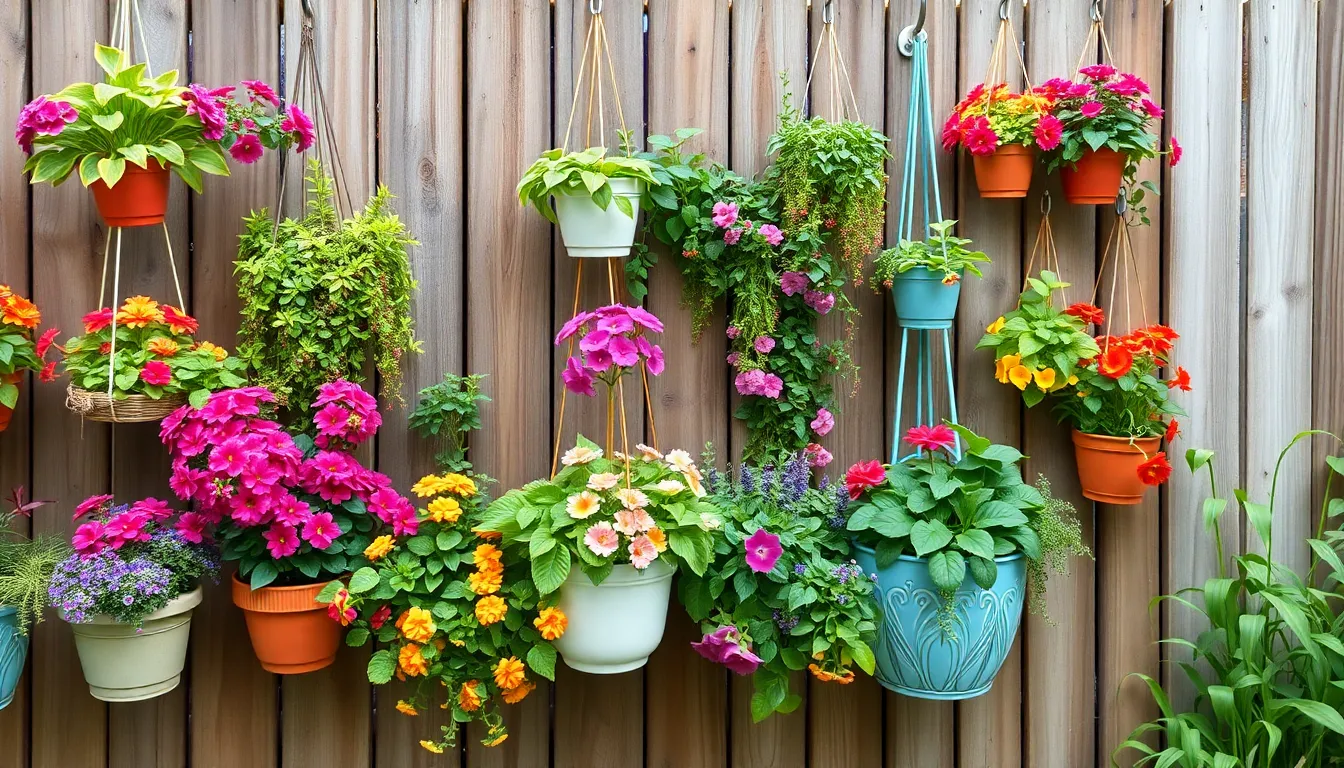
Strategic placement transforms our fence hanging garden from ordinary to extraordinary. We’ll create a stunning visual display by mastering three key design principles that work together harmoniously.
Vary Heights and Container Sizes for Interest
We create ever-changing visual interest by mixing hanging baskets, wall planters, jars, PVC pipes, and gutters in different sizes and shapes. This variety adds depth and dimension that keeps the eye engaged while maximizing our vertical space.
Arranging containers at varying heights breaks monotony and draws attention upward along our fence line. We create layered or tiered effects that make the most of limited space while creating a natural flow throughout our display.
Different sized planters serve different purposes in our design. Large containers anchor the display and house statement plants, while smaller vessels fill gaps and add delicate details that complete our vertical garden composition.
Group Plants by Color and Texture Themes
We cluster plants with complementary colors to create vibrant focal points throughout our fence display. Trailing greenery paired with colorful flowering plants creates stunning contrasts, while succulents add unique textures that catch the light beautifully.
Thematic grouping enhances our overall aesthetic while making maintenance much easier. We can water and care for plants with similar needs all at once, saving time and ensuring consistent plant health across our display.
Contrasting textures add visual weight and sophistication to our arrangement. Smooth succulent leaves paired with feathery ferns or broad leafy plants combined with delicate trailing varieties create compelling combinations that look professional and intentional.
Leave Adequate Space Between Hanging Displays
We space our planters evenly with enough room to allow proper airflow between each container. This prevents overcrowding that can cause plant stress, disease, and poor growth throughout our fence garden.
Adequate spacing lets each plant stand out as an individual element while contributing to the overall design. We avoid cramming too many containers together, which creates a cluttered appearance that diminishes the impact of our carefully chosen plants.
Proper spacing makes watering and care much more accessible for ongoing maintenance. We can easily reach each planter for pruning, deadheading, and inspection without disturbing neighboring plants or struggling with awkward angles.
Maintain Your Fence-Mounted Garden Successfully
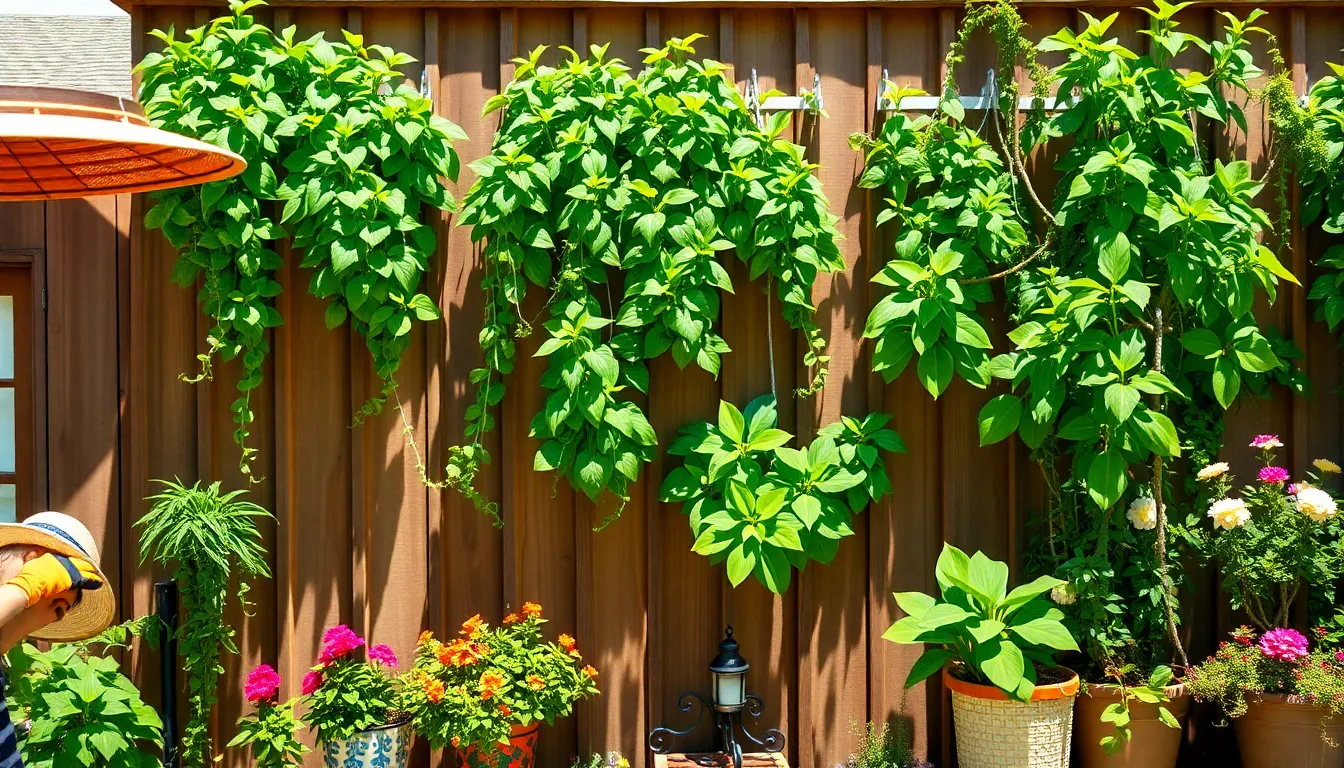
Once we’ve established our beautiful vertical garden, consistent care becomes the foundation of long-term success. The unique environment of fence-mounted plants requires specialized attention to watering, nutrition, and health monitoring.
Establish Regular Watering and Feeding Schedules
Watering frequency needs increase significantly for fence-mounted plants due to faster moisture evaporation and enhanced drainage. We must check soil moisture daily during warm weather and every other day in cooler conditions.
Container plants drain nutrients faster than ground plantings, making regular fertilization essential for vibrant growth. Apply balanced liquid fertilizer every 2-3 weeks during the growing season to replenish depleted nutrients.
Deep watering sessions work better than frequent light sprinklings, ensuring water reaches the entire root system. We should water until excess moisture drains from the bottom of containers, indicating thorough soil saturation.
Morning watering schedules provide optimal results by allowing plants to absorb moisture before afternoon heat increases evaporation rates. Early watering also reduces fungal disease risks by preventing wet foliage overnight.
Prune and Deadhead for Continuous Growth
Regular pruning maintains plant size while promoting bushier, more attractive growth patterns in confined spaces. We recommend trimming back overgrown stems monthly to prevent plants from overwhelming their containers or neighboring plants.
Deadheading spent flowers immediately encourages continuous blooming throughout the growing season. Remove faded blooms by pinching or cutting just above the next set of leaves or flower buds.
Shape control becomes crucial for maintaining visual balance across our fence display. Trim trailing varieties when they extend beyond desired boundaries, and pinch growing tips to encourage lateral branching.
Seasonal pruning schedules vary by plant type, with most flowering varieties benefiting from light pruning after each bloom cycle. Cut back one-third of the plant’s length to stimulate fresh growth and prevent woody stem development.
Monitor for Pests and Disease Issues
Weekly inspections catch problems early before they spread throughout our vertical garden system. We should examine both sides of leaves, stems, and soil surfaces for signs of pest activity or disease symptoms.
Common fence garden pests include aphids, spider mites, and whiteflies that thrive in the exposed conditions of hanging containers. Look for sticky honeydew, webbing, or tiny flying insects around plants.
Fungal diseases develop quickly in humid conditions or when plants lack proper air circulation. Watch for yellowing leaves, black spots, or powdery white coatings that indicate moisture-related problems.
Organic treatment options work effectively for most pest and disease issues without harming beneficial insects or pollinators. Neem oil, insecticidal soap, and copper fungicides provide safe, targeted answers for common problems.
Preventive measures reduce treatment needs by maintaining optimal growing conditions and plant health. Ensure adequate spacing between containers, provide proper drainage, and avoid overhead watering to minimize disease risks.
Solve Common Problems with Hanging Fence Plants
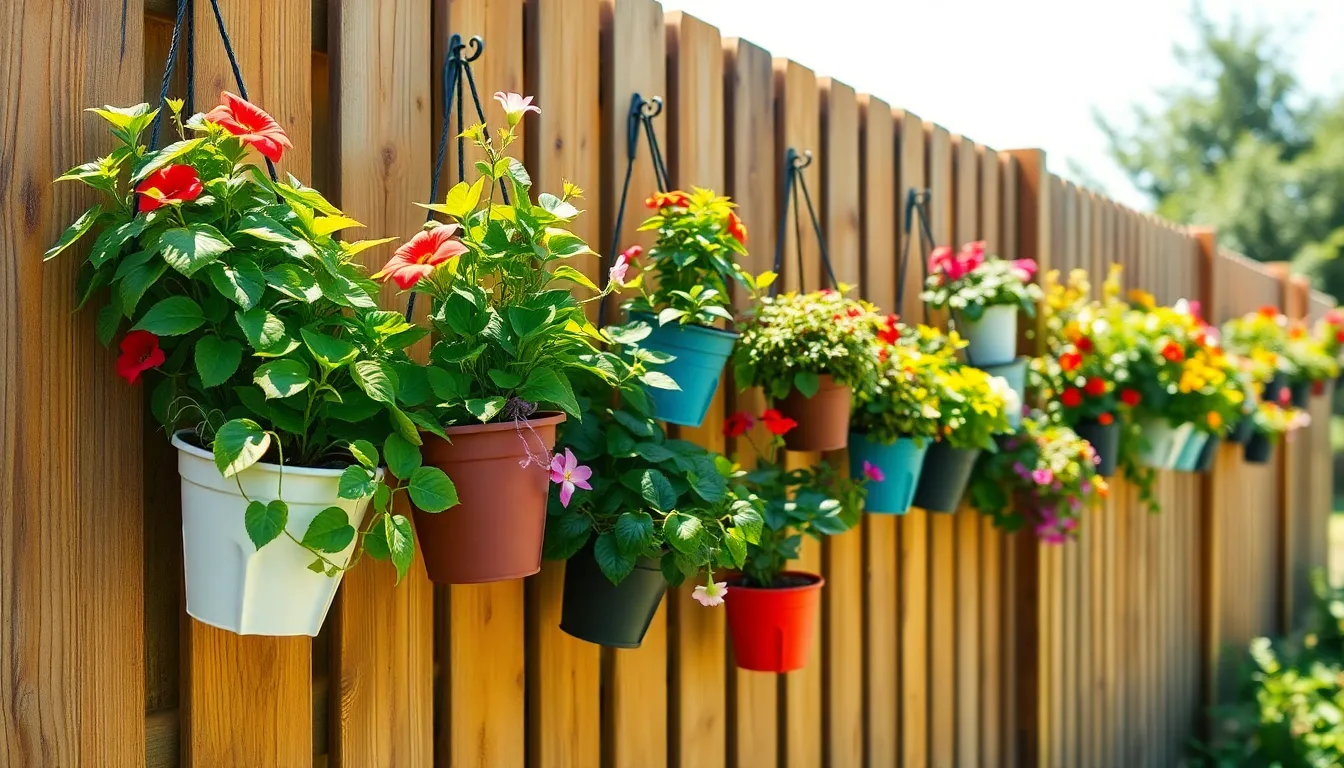
Even well planned fence gardens face challenges that can affect plant health and container security. We’ll help you overcome the most common issues with practical answers that keep your vertical display thriving year round.
Address Watering Challenges and Drainage Issues
Water drainage problems top the list of challenges for fence mounted plants. Gravity causes water to drain quickly from elevated containers, leaving roots dry between waterings. We recommend using planters with multiple drainage holes to prevent waterlogging while maintaining proper moisture levels.
PVC pipes and gutter style planters work exceptionally well for fence installations. These containers allow excess water to escape freely while retaining enough moisture for healthy root systems. Drill additional drainage holes if your chosen planters don’t provide adequate water flow.
Monitor your plants more frequently during hot weather periods. Fence mounted containers dry out faster than ground level pots due to increased air exposure and wind. Check soil moisture daily during summer months to ensure your plants receive consistent hydration.
| Watering Challenge | Solution | Frequency |
|---|---|---|
| Quick drainage | Multiple drainage holes | Install once |
| Dry soil | Daily moisture checks | Summer months |
| Waterlogging | PVC/gutter planters | As needed |
Prevent Wind Damage and Container Swaying
Wind damage poses serious risks to hanging fence plants through container movement and plant stress. Strong gusts can detach poorly secured planters or cause excessive swaying that damages root systems and breaks stems.
Secure attachment methods prevent most wind related problems. Use sturdy metal rings, heavy duty clamps, or reinforced brackets designed specifically for outdoor installations. These hardware options anchor planters firmly to fence surfaces and resist movement during storms.
Position containers strategically to minimize wind exposure. Choose locations that receive natural windbreaks from nearby structures or industry features. Heavier containers resist swaying better than lightweight options, so consider ceramic or thick plastic planters for windy areas.
Create layered arrangements that block wind naturally. Tiered plantings using multiple container levels reduce overall exposure while maximizing growing space along your fence line.
Handle Seasonal Care and Winter Protection
Seasonal temperature changes affect fence mounted plants more severely than ground plantings. Elevated containers experience greater temperature fluctuations and require adjusted care throughout the year.
Move sensitive plants to sheltered locations during winter months. Cold hardy varieties can remain outdoors with proper protection using frost cloths or temporary windbreaks. Reduce watering frequency during plant dormancy while ensuring roots don’t dry completely.
Choose plant varieties suited to your exact climate zone for year round success. Hardy perennials and evergreen options provide consistent coverage without seasonal replacement needs. Research your area’s average low temperatures to select appropriate species.
Consider artificial hedges or faux plants as winter alternatives for continuous fence decoration. Install these options using staples or clips directly to fence surfaces when natural plants require indoor protection during harsh weather periods.
Conclusion
We’ve shown you how to create a stunning vertical garden that transforms any ordinary fence into a living masterpiece. With the right plant selection mounting techniques and design principles you’ll have a thriving display that enhances your outdoor space year-round.
Success with hanging fence plants comes down to understanding your exact conditions and choosing appropriate varieties for your climate and sunlight exposure. Remember that consistent care including proper watering schedules and seasonal maintenance will keep your vertical garden looking its best.
Your fence can become more than just a boundary—it’s an opportunity to maximize growing space add privacy and create visual interest in your industry. Start small with a few containers and expand your hanging garden as you gain confidence and experience.
Frequently Asked Questions
What types of plants work best for hanging fence gardens?
Trailing and cascading plants are ideal for fence displays. Popular choices include pothos, English ivy, petunias, and various succulents. Consider your climate zone and sunlight exposure when selecting plants. For sunny areas, choose sun-loving varieties like petunias, while shade-tolerant plants like pothos work well in darker spots.
How do I choose the right containers for my fence garden?
Select weather-resistant planters with multiple drainage holes to prevent root rot. Use heavy-duty hooks and mounting hardware appropriate for your fence material. Metal rings and clamps provide reliable attachment for both wooden and metal fences. Ensure containers can handle wet soil weight and seasonal variations.
Where should I position plants along my fence for optimal growth?
Assess sunlight patterns throughout the day and match plants to their light requirements. Position heavier planters lower on the fence for stability. Evaluate wind exposure and provide protection when necessary. Plan for easy access to ensure regular maintenance and watering can be performed safely.
How often should I water my hanging fence plants?
Container plants require more frequent watering than ground plantings. Check moisture levels daily during hot weather and water deeply in the morning for optimal absorption. Adjust watering frequency based on weather conditions, plant type, and container size. Ensure proper drainage to prevent waterlogged roots.
What are common problems with hanging fence gardens and how can I prevent them?
Common issues include inadequate drainage, wind damage, and container swaying. Use planters with multiple drainage holes and secure mounting systems. Position containers strategically to minimize wind exposure. Regular inspections for pests and diseases help catch problems early. Proper spacing between containers promotes airflow and prevents overcrowding.
How do I create an attractive design for my vertical fence garden?
Vary container heights and sizes to add depth and dimension. Group plants by color and texture themes for visual cohesion. Create layered effects that draw the eye upward. Ensure adequate spacing between containers for proper airflow. Consider the fence height when selecting plant varieties to maintain proportion and balance.
What maintenance does a fence garden require throughout the year?
Regular watering, feeding, pruning, and deadheading are essential for plant health. Container plants need more frequent fertilization than ground plantings. Inspect regularly for pests and diseases, treating with organic solutions when needed. Protect plants during harsh weather and consider hardy varieties for year-round display.

